The Albanese government cannot be trusted on immigration.
In 2023, former Home Affairs Minister turned Housing Minister Clare O’Neil delivered a keynote address to the AFR Workforce Summit, where she bemoaned the blowout in temporary migrants under the former Coalition government:
Today, really for the first time in our modern history, our uncapped, unplanned temporary program is the centrepiece and driver of our migration system. This simple fact is the source of huge problems…
Since 2005…the number of temporary migrants has exploded. In 2007, we had about 1 million temporary migrants in Australia, excluding visitor and transit visas. Today that number is 1.9 million.
This rather staggering shift in direction has happened without any real policy debate or discussion. It happened not through thoughtful planning and strategy, but by negligence and continental drift. And, this reliance on temporary migration is having enormous economic and social consequences…
Today, many of those 1.9m temporary migrants live in a state of permanent temporariness, unable to invest in their education, get a loan to start a business, or feel emotionally that they can set down roots.
Instead, many are trapped in a Kafkaesque limbo, perpetually filling in forms and cycling through different kinds of temporary visas. Not good for them, not good for the country.
The latest temporary visa data from the Department of Home Affairs shows that there were a record 2,460,000 temporary migrants in Australia (excluding visitors) in Q2 2025, up a whopping 750,000 from when Labor came to office in Q2 2022.
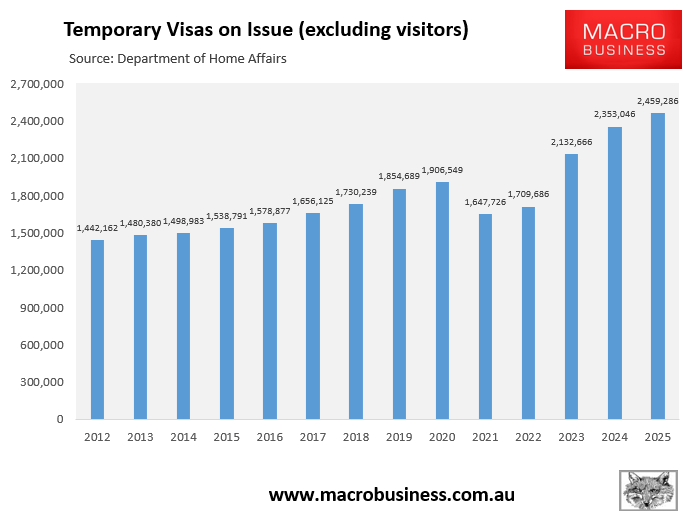
The percentage of Australia’s population on temporary visas has also risen to a record high of 8.9%, up from 6.6% when Labor came to office in Q2 2022 and from 7.4% at the beginning of the pandemic.
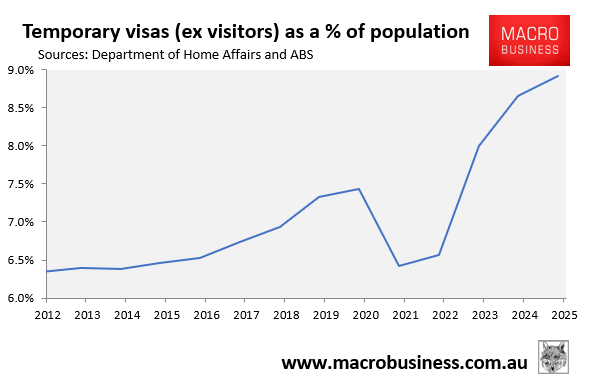
Thus, by Clare O’Neil’s admission, the Albanese government has failed miserably by letting the number of temporary migrants in Australia balloon by 550,000 from the pre-pandemic peak of 1.9 million.
The record blowout in bridging visas under Labor is its other major immigration failure.
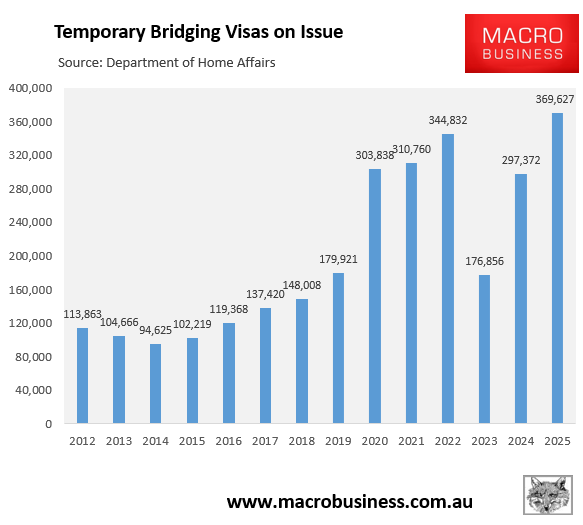
Former high-ranking immigration department bureaucrat Abul Rizvi claims that bridging visas are “the most important barometer of the health of the visa system”.
Bridging visas are typically granted for two reasons:
- Bridging visas were handed out because the Department of Home Affairs was unable to process an onshore visa application before the substantive visa that the applicant was on expired.
- Bridging visas are handed to people whose substantive visas have expired while they make arrangements to depart.
Rizvi regularly attacked the former Coalition government for allowing the number of bridging visas to balloon past 100,000 before the pandemic.

Rizvi claimed that the blowout in bridging visas was evidence of “administrative incompetence”.
Bridging visas ballooned again when borders closed during the pandemic, as temporary migrants on expired visas were unable to leave, so they were handed bridging visas.
However, with borders now fully open, the incompetent Albanese Labor government has allowed bridging visas to balloon to a record high of 370,000 as of Q2 2025.
Therefore, if bridging visas are “the most important barometer of the health of the visa system”, then Labor must be the most incompetent immigration manager in Australia’s history.
But wait, it gets even worse. In February on ABC’s Q&A, Prime Minister Anthony Albanese claimed that the government was cutting immigration and relieving pressure on the housing market by reducing international student numbers, which was being “abused”.
“On immigration, particularly when it comes to housing, three quick points. One is that the biggest thing that you could do, area where you could reduce the amount, is in students, because some of that, frankly, was being abused”.
“We tried to do that through legislation. Peter Dutton opposed that so it wouldn’t go through. It didn’t go through the Senate. So we’ve done it another way”.
Yet, the latest data from the Department of Home Affairs shows that the number of people in Australia on either a student or graduate visa was only a whisker below all-time highs and 166,000 above pre-pandemic levels:
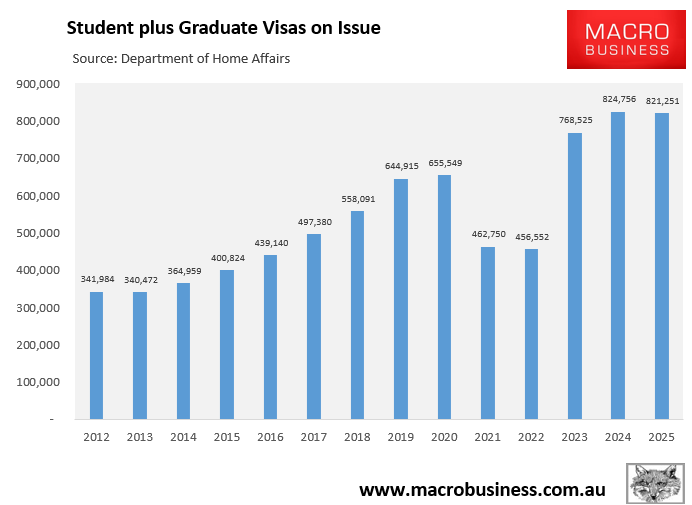
People on student and graduate visas comprised 3% of Australia’s population—almost one in 30 people—as of Q2 2025. This was up from 2.6% at the pre-pandemic peak and double the 1.5% share in 2012.
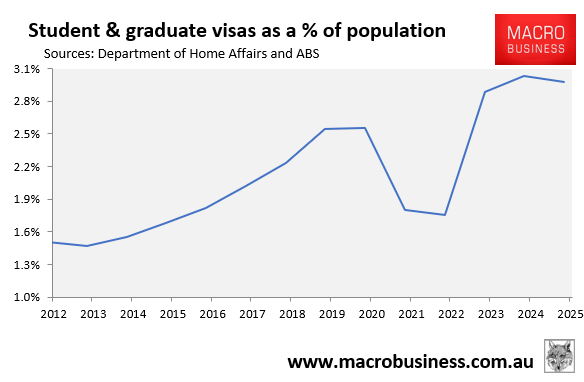
The latest data from the Department of Education showed that there were a record 794,113 international students enrolled in Australian courses in the year to April 2025.
International student enrolments were around 17,000 higher than in 2024 and 105,000 higher than the pre-pandemic peak in 2020.
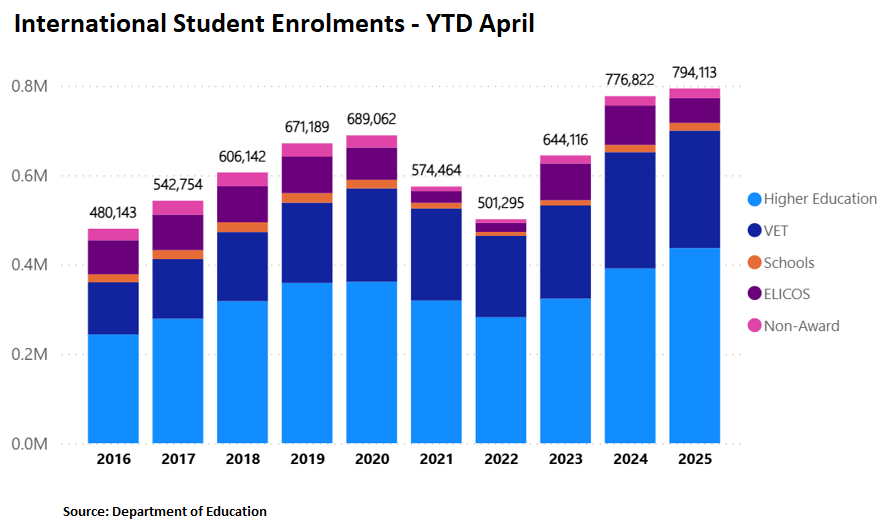
The Albanese government has raised the planning level for international students by 25,000 to 295,000 for 2026.
As a result, Australia’s international student and temporary visa numbers—which are already the highest in the advanced world relative to our population—will increase further.
Labor lied when it said that it would run a smaller and less temporary immigration program. Australia’s immigration program is larger and more temporary than ever.

